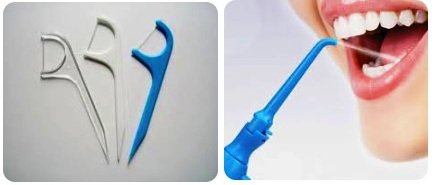Brushing your teeth is essential, but it doesn’t reach every crevice. That’s where flossing tools come in. In this guide, we’ll walk you through what flossing tools are, why they matter, how to choose the right tool for your mouth, and how to use them correctly. Whether you’re looking for the best flossing tool or trying to decide between a water flosser vs string floss, this article has you covered.
Table of Contents
Why Flossing Tools Matter (Benefits & Importance)
- Flossing helps remove plaque and food particles from between teeth and just under the gumline — areas your toothbrush can’t reach. ADA
- This reduces the risk of gum disease (gingivitis, periodontitis), tooth decay, and bad breath. Healthline
- Studies suggest that consistent flossing contributes to overall oral health, which in turn impacts systemic health (e.g. lowering inflammation). UT Health San Antoni
- Even 1–2 days of skipping flossing can lead to plaque buildup and gum bleeding. (From Mayo Clinic Q&A) Mayo Clinic
Because of this, the American Dental Association and other dental bodies recommend that flossing (or using an interdental cleaner) is part of routine oral hygiene. ADA
Types of Flossing Tools: Strengths & Use Cases
There’s no one-size-fits-all tool. The best flossing tool is the one you’ll use consistently. Below are common categories:
| Tool | Description / How It Works | Ideal For / Strengths | Limitations / Disadvantages |
|---|---|---|---|
| Traditional String Floss (waxed, unwaxed, PTFE, tape) | A thin thread (nylon or PTFE) you wrap and slide between teeth | Versatile, inexpensive, good for tight contacts | Requires manual dexterity, can snap / shred |
| Floss Picks / Flossers | A plastic handle with a small floss segment attached | Easier grip, good for back teeth, portable | Less control, limited floss length |
| Interdental Brushes / Proximal Brushes | Tiny bristled brush that fits between teeth | Excellent for wider gaps, implants, braces | Not ideal for very tight spaces |
| Water Flossers / Oral Irrigators | Pulsating water jets to flush debris between teeth and gums | Good for people with braces, implants, dexterity issues | Requires electricity / water, might splash |
| Air / Sonic Flossers | Use bursts of air or sonic pulses to dislodge debris | Newer option, minimal contact | Less common, may be costlier, limited evidence |
| Super Floss / Threader Floss | Pre-cut floss with a stiff end (like for braces/bridges) | Useful for braces, fixed bridges, wide spaces | Bulkier, not suited for every gap |
Notes & variants:
- Waxed vs Unwaxed Floss: Waxed glides more easily through tight areas; unwaxed can feel “grippier.” No strong evidence that one is significantly more effective than the other. Colgate
- PTFE / Monofilament Floss: Highly smooth, tear-resistant floss that glides into tight contacts with less shredding. caryfamilydentistry.com
- Dental Tape: Wide, flat floss (tape) that is gentler on gums and may cover more surface area, good for people with wider interspaces. Dr. Scott Schwartz
When the gap between your teeth is narrow, floss or super floss may work best. Where gaps are wider, interdental brushes may give better efficiency. silbermandentalgroup.com
Water Flosser vs String Floss — Which is Better?
This is a common question, and the answer: both have merits, and they are not strictly “either/or” for everyone.
Strengths of water flossers:
- They are gentle on gums while effectively flushing plaque and debris.
- They are especially helpful for people with braces, implants, bridges, or who struggle with manual flossing.
- Many models offer adjustable pressure settings and tips for various areas of the mouth.
Strengths of string floss (traditional):
- Very cost-effective, portable, no power needed.
- Excellent direct physical contact: floss wraps around the tooth surface and can scrape off plaque mechanically.
- Good for very tight contacts where water or brush might not dislodge debris.
Which to pick / combine:
- For many users, combining both (e.g. traditional floss + water flosser) can yield better plaque removal.
- If dexterity or manual flossing is difficult, a water flosser is a strong alternative.
- If pressure settings are available, start low and gently increase to avoid hurting gums.
- Always follow manufacturer guidance, and consult your dentist if uncertain.
How to Choose the Right Flossing Tool for You
Here are decision factors and tips:
- Spacing between teeth
- Tight contacts → use thin, PTFE, or waxed floss
- Wider gaps / orthodontic work → interdental brushes, floss picks
- Gum / tissue sensitivity
- Sensitive gums may prefer gentler options (soft floss, low-pressure water flosser)
- Oral appliances
- Braces, bridges, implants require more specialized options like super floss, threaders, or water flossers
- Dexterity / physical limitations
- Floss picks, handles, water flossers reduce the need for complex finger manipulation
- Portability / convenience
- Floss picks or compact flossers are good for travel or on-the-go use
- Maintenance / cost
- Consider how often you’ll need replacements (floss, brush heads, water reservoirs)
- Environmental concerns
- Biodegradable floss, refillable picks, and devices with replaceable parts help reduce plastic waste
- Compliance (you’ll actually use it daily!)
- The best tool is the one you will use consistently. Ease and comfort matter greatly.
How to Use Flossing Tools Correctly (Technique & Tips)
Using a flossing tool incorrectly reduces its benefit or may cause injury. Here’s how to floss properly:
For string floss / floss picks:
- Use ~18 inches (45 cm) of floss, wrap ends around your fingers (for string).
- Slide floss gently between two teeth (don’t snap).
- When floss reaches the gumline, curve it around the side of one tooth (a “C-shape”) and slide it up and down (go a little under the gum line).
- Repeat for the other adjacent tooth.
- Move to a fresh segment of floss as you go along — don’t reuse the same spot.
- For floss picks, use similar motion gently, being careful near the gumline.
For interdental brushes:
- Gently insert the brush between teeth, wiggle slightly, and move back and forth (don’t force).
- Rinse brush when dirty, and replace when bristles bend or wear.
For water flossers:
- Lean over sink to avoid splashes.
- Start with lowest pressure, aim tip at your gumline at ~90°, and move slowly along the gumline.
- Pause briefly between teeth to let water flush.
- Follow manufacturer guidance on duration (often 30–60 seconds).
Tips for successful flossing:
- Floss once per day, preferably before brushing your teeth.
- Be gentle; hurting gums is counterproductive.
- If bleeding occurs initially, persist for a few days (if mild). Bleeding often reduces as gums heal.
- Replace or clean tools (brushes, nozzles) regularly.
- Visit your dentist / hygienist regularly for checkups and professional cleaning.
Product Examples & Recommendations (with Caution on Endorsement)
Here are examples of flossing tools that are popular / well reviewed (for illustrative purposes):
- Waterpik Aquarius / Cordless Advanced — ADA accepted, adjustable settings, many tips available
- PTFE / “Glide” floss brands (e.g. “Oral-B Glide”) — smooth, tear-resistant floss
- DenTek / Plackers floss picks — popular pick-style flossers
- Interdental brush brands — various sizes for different gaps
- Biodegradable / eco floss picks — options made from bamboo, plant fibers
Note: Always disclose conflicts of interest and check for latest reviews / ADA seals before recommending a specific product.
Common Myths & FAQs
Q: Does flossing make gums bleed and harm them?
A: It’s common for gums to bleed slightly when you first start flossing, especially if you haven’t flossed regularly before. This bleeding usually indicates mild inflammation or gingivitis, not damage. When plaque and bacteria accumulate along the gumline, they irritate the tissue. Once you begin flossing, you disturb this buildup — and the inflamed gums react by bleeding.
With consistent and gentle flossing, this bleeding typically stops within a few days to a week as your gums become healthier and less inflamed. Think of it like starting a new exercise routine — your muscles may be sore initially, but that’s part of the adaptation process. Similarly, gums “toughen up” with regular cleaning.
However, flossing should never be aggressive. Snapping the floss or forcing it between tight contacts can cut the gums and cause real injury. Always guide the floss gently in a “C” shape around each tooth, moving it up and down rather than sawing back and forth.
If bleeding persists beyond a week or worsens, it may signal deeper gum disease (periodontitis) or improper technique — that’s the time to see a dentist or hygienist.
In short, gentle, regular flossing strengthens gums, while neglect or rough handling causes harm. The key is consistency and correct technique.
Q: Is flossing unnecessary if you use a water flosser?
A: This is one of the most debated questions in modern oral hygiene — and the short answer is no, water flossing does not make traditional flossing unnecessary.
A water flosser (also known as an oral irrigator) uses a stream of pulsating water to remove food debris and plaque from between teeth and along the gumline. It’s excellent for people who wear braces, have dental implants or bridges, or struggle with dexterity issues that make string flossing difficult.
Multiple studies have shown that water flossers reduce bleeding and gingival inflammation, often more comfortably than string floss. However, water pressure alone does not scrape away sticky plaque film as effectively as physical floss contact does. Traditional floss can wrap around the tooth surface and mechanically dislodge biofilm, something water alone can’t fully replace.
That’s why most dentists recommend a hybrid approach:
- Use water flossers to flush out debris, especially from hard-to-reach areas or around orthodontic appliances.
- Use traditional floss or interdental brushes for physical plaque removal once daily.
Together, they offer the most complete cleaning possible. So while a water flosser is a powerful tool, it’s best viewed as a complement, not a substitute, for manual flossing.
Q: Does one type of floss outperform the other?
A: There’s no single “best” floss for everyone — effectiveness depends more on how and how often you floss rather than what kind of floss you use.
Different floss types are designed to meet different needs:
- Waxed floss glides smoothly between tight teeth and is less likely to shred.
- Unwaxed floss offers more grip on plaque but can fray more easily.
- PTFE floss (like Oral-B Glide) slides easily and resists tearing, great for very tight spaces.
- Dental tape is broader and gentler, ideal for people with wider gaps or sensitive gums.
- Super floss or threader floss helps people with braces, bridges, or implants reach under appliances.
- Eco-friendly / biodegradable floss appeals to sustainability-conscious users without compromising on performance.
Clinical comparisons show that when used properly, no type of floss consistently outperforms another in plaque reduction or gum health improvement. The key variables are technique, consistency, and comfort. If the floss feels comfortable and you’ll actually use it daily, that’s the best one for you.
Q: How often should I floss?
A: Dentists and the American Dental Association (ADA) recommend flossing at least once per day — ideally before brushing your teeth. The reason? Flossing removes trapped food and plaque between teeth, making brushing afterward far more effective. When you floss after brushing, you may leave debris sitting between teeth, where it can continue to feed bacteria.
Here’s how timing influences results:
- Floss before brushing → removes interdental debris, allowing fluoride from toothpaste to reach between teeth.
- Floss after brushing → may feel cleaner immediately but might not deliver optimal fluoride contact.
If you have gum disease, orthodontic appliances, or dental implants, your dentist may advise flossing twice daily or combining traditional floss with an interdental brush or water flosser.
Ultimately, it’s consistency, not timing perfection, that matters most. A gentle daily flossing habit — even once — can dramatically reduce your risk of gum inflammation, bleeding, and decay.
Conclusion & Takeaways
- Flossing tools are essential complements to brushing — they reach areas a toothbrush doesn’t.
- The “best” flossing tool depends on your teeth spacing, dexterity, appliances (braces, implants), and comfort.
- Proper technique matters as much as the tool itself.
- Consistency is key — using a tool imperfectly but daily is better than perfect use rarely.
- Don’t hesitate to ask your dentist/hygienist which tool suits your mouth and get hands-on instruction.
Read Also:
1) Root Canal Infected Tooth: Symptoms, X-Ray, Treatment & Prevention
2) Sideways Wisdom Teeth: Symptoms, Extraction, Recovery & Treatment Guide
3) Root Canal Infections: What You Need to Know When Things Go Wrong
4) Top 10 dentists in duluth mn that are best at creating dentures




